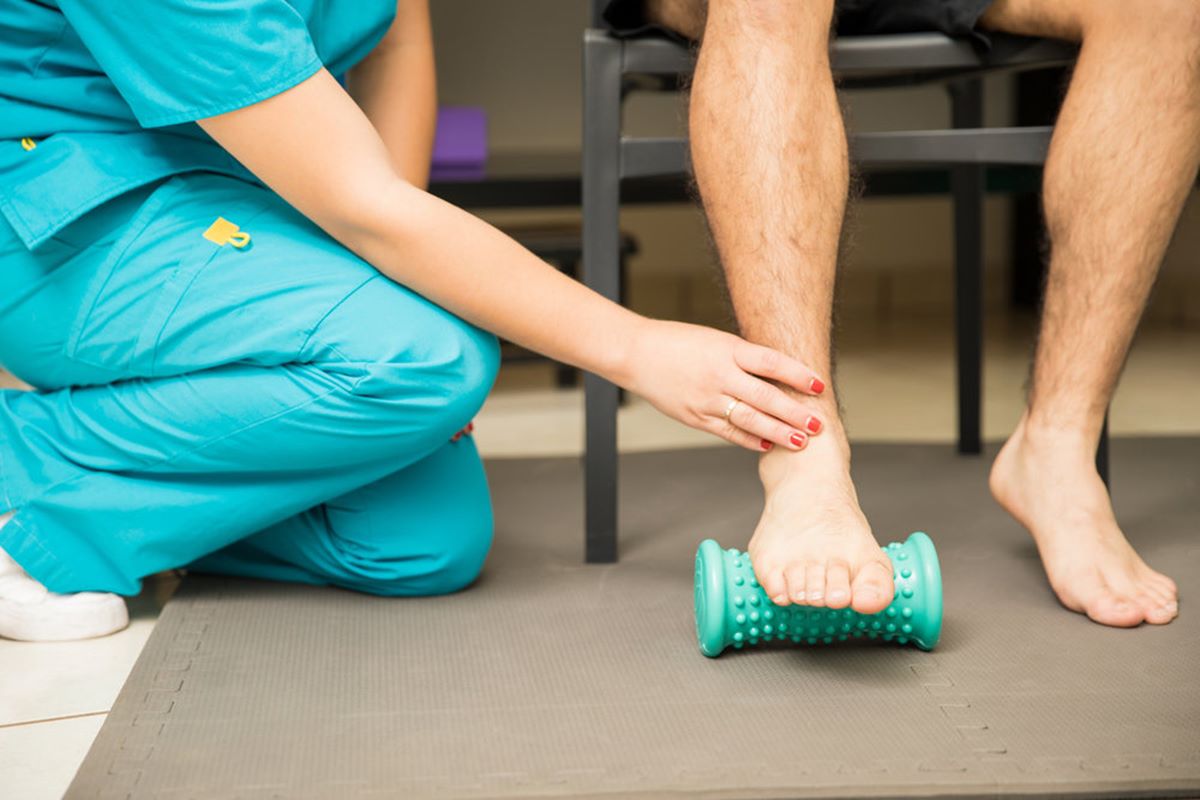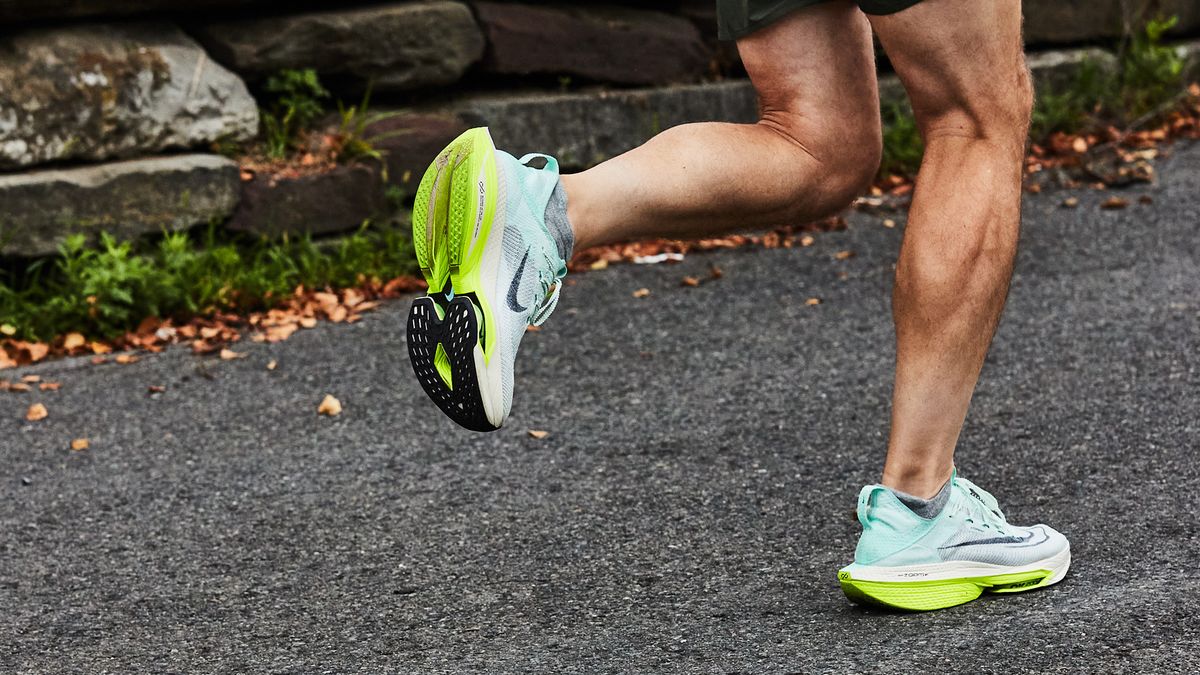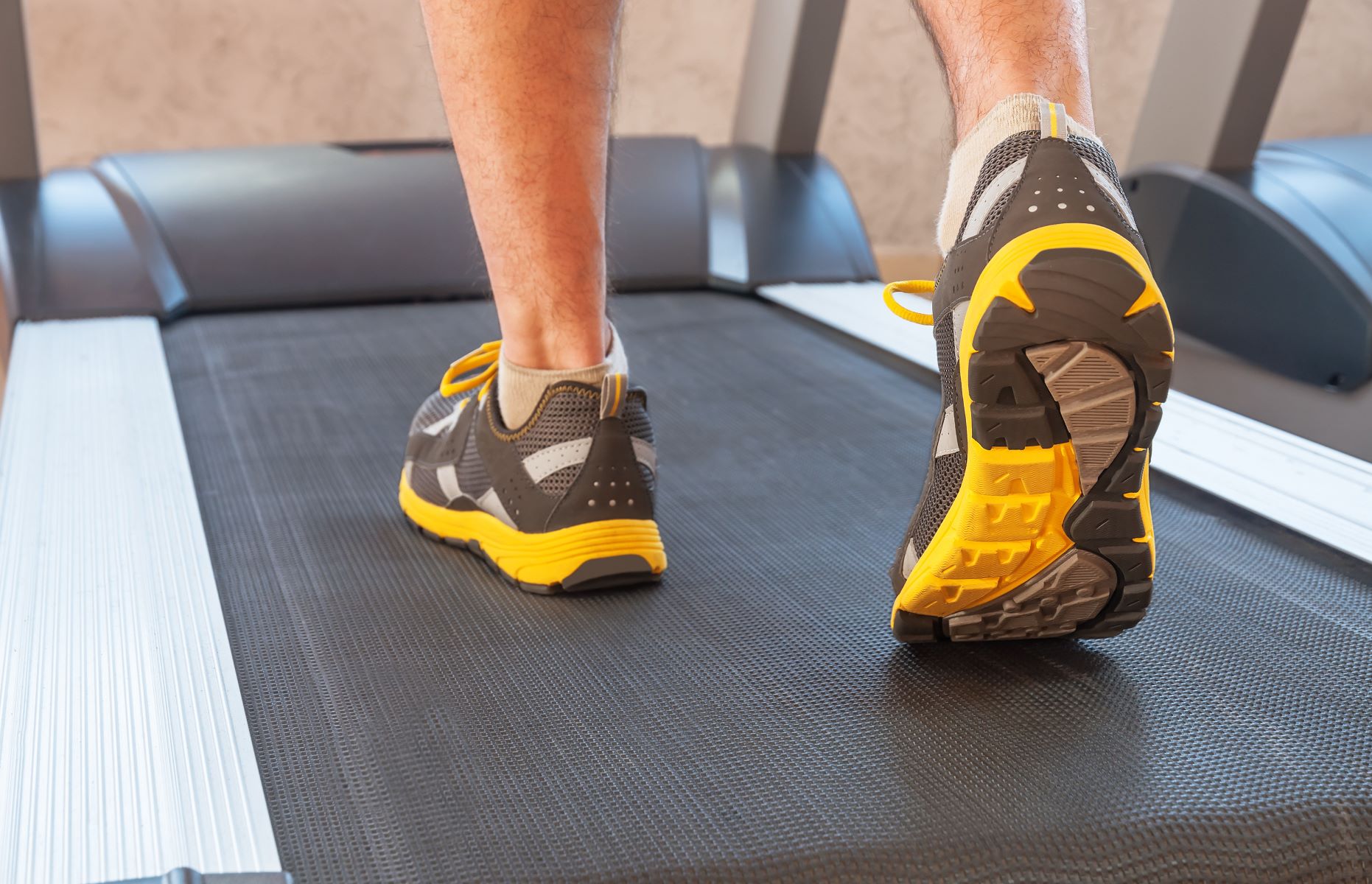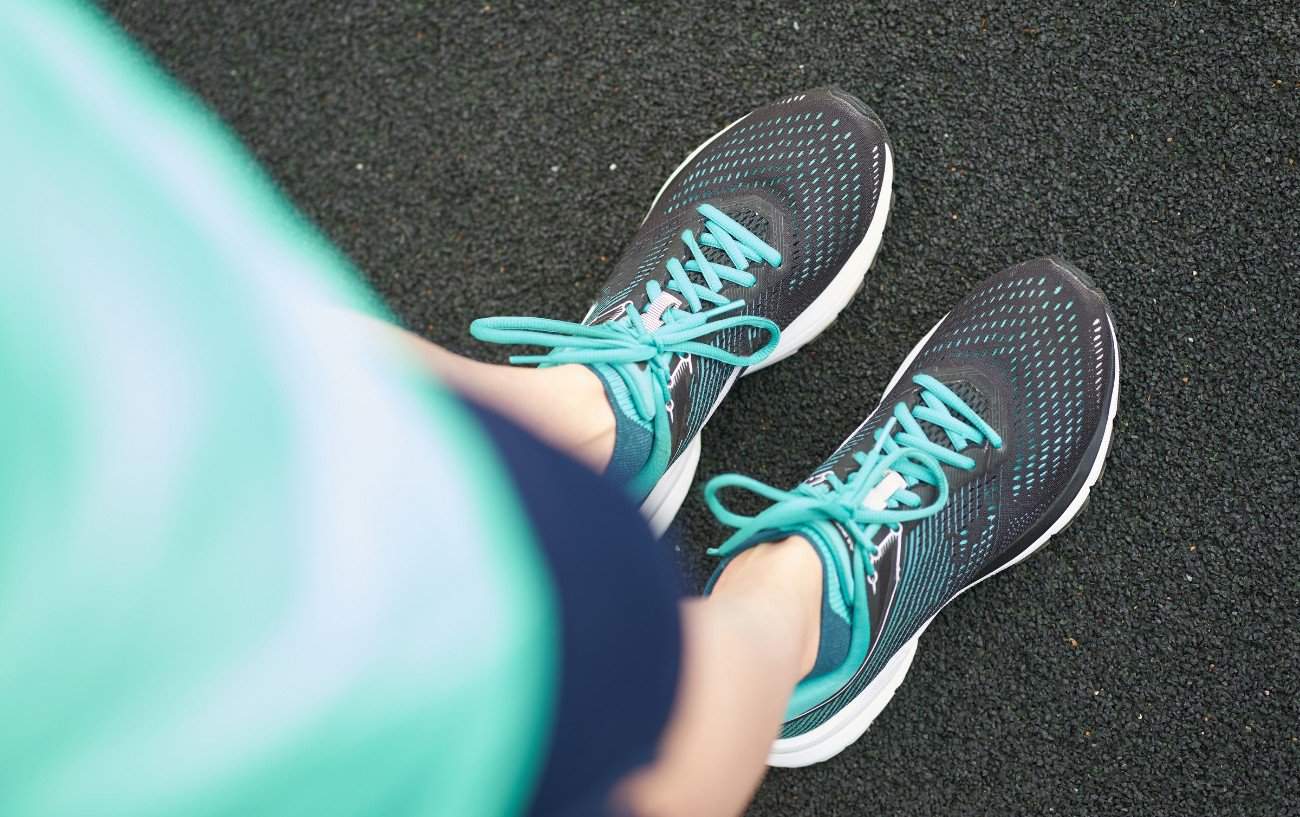

Featured
How To Exercise With Plantar Fasciitis
Published: October 1, 2023
Learn how to exercise with plantar fasciitis, a common foot condition. Discover featured exercises and tips to stay active while managing your symptoms.
Introduction
Plantar fasciitis is a common condition that affects the foot and causes pain in the heel and bottom of the foot. It occurs when the plantar fascia, a thick band of tissue that supports the arch of the foot, becomes inflamed and irritated. This condition can make it difficult to engage in physical activities, including exercise. However, with proper precautions and modifications to your routine, it is possible to stay active and maintain your fitness level while managing plantar fasciitis.
In this article, we will provide a comprehensive guide on how to exercise with plantar fasciitis. We will discuss the causes of plantar fasciitis, the recommended exercises, stretching and strengthening exercises specifically targeted for this condition, and low-impact cardio exercises that are safe for individuals with plantar fasciitis. Additionally, we will provide helpful tips to ensure you can exercise without exacerbating your symptoms.
It is important to note that before starting any exercise program, it is recommended to consult with a healthcare professional or a physical therapist who can evaluate your specific condition and provide personalized advice based on your needs. Remember, everyone’s experience with plantar fasciitis may differ, and it’s crucial to listen to your body and make modifications as necessary.
By incorporating these exercises and tips into your routine, you can continue to pursue an active lifestyle while managing the symptoms of plantar fasciitis. Let’s dive in and explore the best ways to exercise with this condition.
Understanding Plantar Fasciitis
Before diving into the exercises and tips for exercising with plantar fasciitis, it’s important to have a clear understanding of what this condition entails. Plantar fasciitis is the most common cause of heel pain, affecting millions of people worldwide. It occurs when the plantar fascia, a thick band of tissue that connects the heel bone to the toes, becomes inflamed and irritated.
The plantar fascia acts as a shock absorber and supports the arch of the foot while walking or standing. However, repetitive strain and excessive pressure on the plantar fascia can lead to small tears and inflammation. This can result in pain, stiffness, and tenderness in the bottom of the foot and heel.
There are several factors that can increase the risk of developing plantar fasciitis. These include:
- Physical activities that place excessive stress on the feet, such as running, jumping, or dancing.
- Being overweight or obese, which adds extra strain on the feet and arches.
- Wearing improper or unsupportive footwear that fails to cushion and support the feet adequately.
- Having tight calf muscles or Achilles tendons, which can alter the mechanics of the feet and contribute to plantar fasciitis.
- Having an abnormal foot structure, such as flat feet or high arches, which can increase the risk of developing this condition.
- Engaging in occupations or activities that require prolonged standing or walking on hard surfaces.
It’s important to note that while plantar fasciitis is a common condition, it can be effectively managed with proper care and treatment. Understanding the causes and risk factors of plantar fasciitis can help individuals make informed decisions when it comes to exercise and self-care.
Now that we have a solid understanding of plantar fasciitis, let’s move on to discuss how you can prepare to exercise while managing this condition.
Common Causes of Plantar Fasciitis
Plantar fasciitis can be caused by a variety of factors, many of which can be attributed to lifestyle choices and activities. Understanding the common causes of this condition can help individuals identify potential triggers and take steps to prevent or manage their symptoms.
One of the primary causes of plantar fasciitis is repetitive strain on the plantar fascia. This can occur from activities that involve excessive pressure on the feet, such as running, jumping, or dancing. These high-impact activities can put a significant amount of stress on the fascia, leading to inflammation and pain.
Another common cause of plantar fasciitis is wearing improper or unsupportive footwear. Shoes that lack proper cushioning and arch support can fail to absorb shock adequately, placing additional strain on the plantar fascia. It is important to choose shoes that provide proper support and cushioning for the feet, especially if engaging in physical activities.
Weight can also be a contributing factor to plantar fasciitis. Individuals who are overweight or obese are more prone to developing this condition due to the increased pressure on the feet. The excess weight places additional stress on the plantar fascia, which can lead to inflammation and pain.
Tight calf muscles and Achilles tendons can also contribute to plantar fasciitis. When these muscles and tendons are tight, they can alter the mechanics of the foot, pulling on the plantar fascia and causing strain. Regular stretching and flexibility exercises can help alleviate tightness in these areas and reduce the risk of developing plantar fasciitis.
It’s worth noting that certain foot structures can predispose individuals to plantar fasciitis. Flat feet or high arches can alter the distribution of weight and stress on the feet, increasing the likelihood of developing this condition. Individuals with abnormal foot structures should pay extra attention to proper footwear and consider using orthotic inserts to provide additional support.
Finally, occupations or activities that require prolonged standing or walking on hard surfaces can also contribute to plantar fasciitis. Constant pressure on the feet without adequate rest and support can lead to inflammation and discomfort.
By understanding the common causes of plantar fasciitis, individuals can make informed decisions regarding their lifestyle and choices. This knowledge is crucial for preventing and managing the symptoms of this condition effectively.
Preparing to Exercise with Plantar Fasciitis
Exercising with plantar fasciitis requires careful preparation to minimize pain and prevent further damage to the fascia. Before starting any exercise routine, it is essential to take certain steps to ensure that you are ready for physical activity while managing this condition.
The first step in preparing to exercise with plantar fasciitis is to consult with a healthcare professional or physical therapist. They can evaluate your specific condition and provide guidance on what types of exercises are appropriate for you. They may also recommend additional treatments, such as orthotic inserts or physical therapy, to support your exercise regimen.
Next, it is important to choose the right footwear. Investing in shoes that provide adequate arch support, cushioning, and stability is crucial for individuals with plantar fasciitis. Look for shoes with a supportive heel counter and a flexible sole to provide proper shock absorption and minimize strain on the fascia. Avoid worn-out or unsupportive shoes as they can exacerbate your symptoms.
Prior to exercising, it is essential to warm up properly. Engaging in a dynamic warm-up routine that includes gentle stretching and mobility exercises will help prepare your muscles, tendons, and fascia for activity. Focus on stretching the calf muscles, Achilles tendon, and the plantar fascia itself to reduce tension and increase flexibility.
When it comes to exercising with plantar fasciitis, it is crucial to listen to your body. Pay attention to any pain or discomfort during exercise and modify or stop the activity if necessary. Start slowly and gradually increase the intensity and duration of your workouts to prevent overexertion and further strain on the plantar fascia.
Another key aspect of preparing for exercise with plantar fasciitis is incorporating regular rest and recovery days into your routine. Give your body time to heal and allow the inflammation to subside before engaging in high-impact activities. Cross-training with low-impact exercises or alternate days of strength training can help reduce the stress on the plantar fascia while still maintaining fitness.
Lastly, it is important to incorporate proper foot care into your routine. Keeping your feet clean, moisturized, and properly supported can help prevent additional complications and discomfort. Massage your feet, use ice or contrast baths to reduce inflammation, and wear supportive footwear even when not exercising.
By taking the necessary precautions and preparing your body for exercise, you can minimize pain and discomfort while effectively managing plantar fasciitis. In the next sections, we will explore specific exercises and stretches that can help alleviate symptoms and strengthen the foot muscles.
Recommended Exercises for Plantar Fasciitis
Exercises specifically targeting the plantar fascia and surrounding muscles can be beneficial for individuals with plantar fasciitis. These exercises aim to stretch and strengthen the foot muscles, improve flexibility, and alleviate pain and discomfort. Incorporating these exercises into your routine can help promote healing and prevent further damage to the plantar fascia.
One of the most effective exercises for plantar fasciitis is the towel stretch. To perform this stretch, sit on a chair with one leg extended in front of you. Place a towel around the ball of your foot, holding the ends in your hands. Gently pull the towel towards you, stretching the foot and calf muscles. Hold the stretch for 30 seconds and repeat three times on each foot.
Another beneficial exercise is toe curls. Begin by sitting on a chair and placing a towel on the floor in front of you. With bare feet, use your toes to scrunch the towel towards you, then release. Repeat this exercise for 10 repetitions on each foot. Toe curls help strengthen the muscles in the arch of the foot, providing support to the plantar fascia.
Toe spreads are another excellent exercise for plantar fasciitis. Start by sitting on a chair and placing a small ball or foam roller between your feet. Using your toes, try to spread the ball or roller apart, then release. Repeat this exercise for 10 repetitions to improve foot strength and flexibility.
Calf stretches are essential for maintaining flexibility in the calf muscles and reducing strain on the plantar fascia. Stand facing a wall with one foot in front of the other. Place your hands on the wall for support and gently lean forward, keeping your back leg straight and feeling a stretch in the calf of the back leg. Hold for 30 seconds, then switch legs and repeat for three sets on each side.
In addition to specific exercises, it is crucial to engage in low-impact cardio activities that minimize stress on the feet. Swimming, cycling, and using an elliptical machine are all excellent choices for individuals with plantar fasciitis. These activities provide cardiovascular benefits without putting excessive strain on the plantar fascia.
It’s important to note that while these exercises can be beneficial for most individuals with plantar fasciitis, everyone’s condition is unique. It is always recommended to consult with a healthcare professional or physical therapist before starting any exercise program to ensure it is appropriate for your specific needs.
By incorporating these recommended exercises into your routine, you can strengthen the foot muscles, improve flexibility, and reduce pain associated with plantar fasciitis. However, it is essential to perform these exercises correctly and listen to your body. If any exercise causes increased pain or discomfort, stop and consult with a healthcare professional.
Stretching Exercises for Plantar Fasciitis
Stretching is a crucial component of managing plantar fasciitis. Regular stretching exercises can help improve flexibility, reduce tension in the foot muscles, and alleviate pain and discomfort. By incorporating these stretching exercises into your routine, you can provide relief for the plantar fascia and promote recovery.
One of the most effective stretches for plantar fasciitis is the calf stretch. Stand facing a wall with one foot in front of the other. Place your hands on the wall for support and gently lean forward, keeping your back leg straight and feeling a stretch in the calf of the back leg. Hold the stretch for 30 seconds and repeat three times on each leg. This stretch helps lengthen the calf muscles and creates less tension on the plantar fascia.
The plantar fascia stretch is another beneficial exercise for this condition. Sit on a chair and place one foot on your opposite knee. Using your hand, gently pull your toes back towards you, feeling a stretch along the bottom of your foot. Hold this stretch for 30 seconds, then switch to the other foot. Performing this stretch three times on each foot can help alleviate tension and discomfort in the plantar fascia.
In addition to the plantar fascia stretch, rolling a tennis ball or a frozen water bottle under the arch of your foot can provide relief. Sit on a chair and place the ball or bottle under your foot. Apply gentle pressure as you roll it back and forth, targeting the entire length of your arch. This self-massage technique helps reduce tension and promote blood flow to the area.
The seated toe stretch is another effective exercise for plantar fasciitis. Sit on the edge of a chair and place one foot on your opposite thigh. Use your hand to gently pull your toes back towards you, feeling a stretch in the top of your foot. Hold for 30 seconds and repeat three times on each foot. This stretch targets the muscles on the top of the foot and helps reduce tightness.
Achilles tendon stretches are important as well. Stand facing a wall with one foot in front of the other. Place your hands on the wall for support and bend your front knee while keeping your back leg straight. Feel a stretch in the back of your lower leg. Hold for 30 seconds, then switch legs. Repeat three times on each side. Stretching the Achilles tendon helps alleviate tension on the plantar fascia.
Remember to start each stretching exercise gradually and increase the intensity or duration as tolerated. It is essential to listen to your body and not push beyond your limits. If you experience pain or discomfort during any stretch, stop and consult with a healthcare professional.
By incorporating these stretching exercises into your routine, you can improve flexibility, reduce tension, and promote healing of the plantar fascia. They are valuable tools in managing plantar fasciitis and can provide relief from pain and discomfort.
Strengthening Exercises for Plantar Fasciitis
Strengthening the foot muscles is an essential aspect of managing plantar fasciitis. Strong muscles can provide support to the plantar fascia, reduce strain on the foot, and help alleviate pain and discomfort. Incorporating specific strengthening exercises into your routine can help improve the overall strength and stability of your feet.
To strengthen the arch of your foot, perform an exercise called toe curls. Sit on a chair and place a towel on the floor in front of you. With bare feet, use your toes to scrunch the towel towards you, then release. Repeat this exercise for 10 repetitions on each foot. Toe curls target the muscles in the arch, providing support to the plantar fascia.
Another effective exercise is the heel raise. Stand with your feet shoulder-width apart, and slowly rise up onto your toes, lifting your heels off the ground. Hold for a few seconds and then lower back down. Repeat this exercise for 10-15 repetitions. Heel raises strengthen the calf muscles, which in turn provide support to the plantar fascia.
The marble pickup exercise is a simple yet effective way to strengthen the toes and the arch of the foot. Place a small bowl or container with marbles on the floor. Using only your toes, pick up each marble and place it in another container. Aim to pick up 10 marbles with each foot. This exercise targets the muscles in the foot, improving strength and control.
To strengthen the muscles on the top of your foot, perform the resisted dorsiflexion exercise. Sit on a chair with your foot resting on a towel. Place a resistance band around the top of your foot and hold the other end with your hand. Gently flex your foot upward against the resistance band, then release. Repeat for 10-15 repetitions on each foot. This exercise helps strengthen the muscles that support the arch and reduce strain on the plantar fascia.
Additionally, calf raises can help strengthen the muscles in your lower leg, providing support to the plantar fascia. Stand with your feet hip-width apart, and slowly rise up onto your toes, lifting your heels off the ground. Hold for a few seconds, then lower back down. Repeat for 10-15 repetitions. This exercise targets the calves and can help improve stability and reduce strain on the foot.
It is important to start these strengthening exercises gradually and increase the intensity or difficulty as tolerated. The goal is to build strength over time and not to overexert the foot. If you experience pain or discomfort during any of these exercises, stop and consult with a healthcare professional.
By incorporating these strengthening exercises into your routine, you can improve the strength and stability of your feet, providing support to the plantar fascia and reducing pain and discomfort associated with plantar fasciitis.
Low-Impact Cardio Exercises for Plantar Fasciitis
When dealing with plantar fasciitis, engaging in low-impact cardio exercises is a safer alternative to high-impact activities that can exacerbate symptoms. These exercises provide cardiovascular benefits while minimizing stress on the plantar fascia. By incorporating low-impact cardio into your routine, you can maintain fitness levels and manage plantar fasciitis effectively.
One great low-impact cardio exercise is swimming. Swimming provides a full-body workout without putting any weight or pressure on the feet. Whether you choose to swim laps or participate in aqua aerobics, the buoyancy of the water reduces the impact on the plantar fascia, allowing for a challenging but safe workout.
Cycling is another excellent option for individuals with plantar fasciitis. Whether using a stationary bike or going for a bike ride outdoors, cycling offers a low-impact way to get your heart rate up. Adjust the resistance level to your comfort and duration to your fitness level to have an effective cardio workout without placing strain on the feet.
Using an elliptical machine is another low-impact cardio exercise that minimizes stress on the plantar fascia. The elliptical provides a smooth, gliding motion that allows for a challenging workout without the jarring impact experienced with running or jumping. Adjust the resistance and incline settings to suit your fitness level.
Rowing is an often-overlooked low-impact cardio exercise that engages multiple muscle groups in the body. Whether using a rowing machine or participating in a rowing class, rowing provides a cardiovascular workout while placing little to no weight-bearing pressure on the feet. It also helps improve posture and strengthen the upper body.
Walking is a low-impact exercise that can be modified to accommodate plantar fasciitis. For individuals with severe symptoms, walking on a cushioned or softer surface, such as a track or grass, can help reduce the impact on the feet. Gradually increase the distance and pace as tolerated, and listen to your body for any signs of discomfort.
It is important to incorporate a proper warm-up and cool-down routine before and after low-impact cardio exercises. A dynamic warm-up, including light stretching and mobility exercises, prepares the muscles and joints for activity. Afterward, static stretching and gentle cooldown exercises can help prevent muscle tightness and promote recovery.
Remember, everyone’s experience with plantar fasciitis may vary, so it’s essential to listen to your body and make modifications as needed. If you experience pain or discomfort during any low-impact cardio exercise, it is advisable to consult with a healthcare professional or physical therapist.
By incorporating low-impact cardio exercises into your routine, you can maintain cardiovascular fitness without aggravating your plantar fasciitis. These exercises provide a variety of options to keep you active and fit, while still allowing your feet to heal and recover.
Tips for Exercising with Plantar Fasciitis
Exercising with plantar fasciitis requires special attention and care to prevent exacerbating symptoms and promote healing. By following these tips, you can safely engage in physical activity while managing plantar fasciitis.
First and foremost, it is crucial to listen to your body. Pay attention to any pain or discomfort during exercise and adjust or stop the activity if necessary. Pushing through the pain can worsen the condition and delay healing. If an exercise or movement causes increased pain, modify it or try a different exercise altogether.
Start slowly and gradually increase the intensity and duration of your workouts. It’s important not to rush the process and give your body time to adapt and recover. Increase the intensity or duration of your exercises by no more than 10% each week to avoid overexertion and additional strain on the plantar fascia.
Choosing the right footwear is essential. Invest in shoes that provide adequate arch support, cushioning, and stability. Look for shoes specifically designed for individuals with plantar fasciitis or those that offer additional support in the arch area. Replace worn-out shoes to ensure they continue to provide proper shock absorption and support.
Consider using orthotic inserts or shoe inserts prescribed by a healthcare professional. These inserts can provide additional support, stability, and cushioning for the feet. They can help distribute pressure evenly and reduce strain on the plantar fascia during exercise. Consult with a healthcare professional or podiatrist to determine the best type of orthotics for your specific needs.
Ice therapy can be beneficial after exercise to reduce inflammation and soothe the affected area. Apply an ice pack or a frozen water bottle to the bottom of the foot for 10-15 minutes. This can help alleviate pain and reduce swelling. Remember to wrap the ice pack in a towel to prevent direct contact with your skin.
Include regular rest days in your exercise routine. Rest is crucial for allowing the plantar fascia to heal and reducing inflammation. Alternate between cardio and strength training exercises or opt for low-impact activities on rest days to give your feet a break while still maintaining your fitness level.
Stretch regularly, both before and after exercise. Stretching helps improve flexibility, reduce tension in the muscles, and enhance circulation. Focus on stretching the calf muscles, Achilles tendon, and the plantar fascia itself. Hold each stretch for at least 30 seconds and repeat several times on each leg.
Lastly, consider incorporating cross-training into your routine. Engage in exercises that do not place direct stress on the feet, such as swimming, cycling, or using an elliptical machine. Cross-training allows you to continue exercising while minimizing the impact on the plantar fascia and promoting overall fitness and strength.
Remember, every individual is unique, and what works for one person may not work for another. It is always advisable to consult with a healthcare professional or physical therapist before starting any exercise program to ensure it is appropriate for your specific condition and needs.
By following these tips, you can exercise effectively and safely while managing plantar fasciitis. Stay committed to your exercise routine, listen to your body, and make modifications as needed to support your healing journey.
Conclusion
Exercising with plantar fasciitis may require some modifications and extra care, but it is possible to stay active and maintain your fitness level while managing this condition. By understanding the causes and risk factors of plantar fasciitis, as well as implementing appropriate exercises and tips, you can minimize pain, promote healing, and prevent further damage to the plantar fascia.
Remember to consult with a healthcare professional or physical therapist before starting any exercise program. They can provide personalized advice based on your specific condition and needs. The recommendations provided in this article, such as stretching exercises targeting the plantar fascia and surrounding muscles, strengthening exercises for the foot, engaging in low-impact cardio activities, and utilizing proper footwear and orthotic inserts, can help alleviate symptoms and promote recovery.
It’s important to listen to your body and make modifications as necessary during exercise. Start slowly, gradually increase intensity, and give yourself ample rest and recovery days. Incorporate stretching into your routine to improve flexibility and reduce tension in the muscles. Choose low-impact cardio exercises that minimize stress on the feet, such as swimming, cycling, or using an elliptical machine.
By following the tips provided, you can exercise safely and effectively while managing plantar fasciitis. However, it is important to remember that every individual is unique, and what works for one person may not work for another. It is always advisable to consult with a healthcare professional to ensure the exercises and recommendations are suitable for your specific condition and needs.
With dedication, patience, and a well-rounded approach to managing plantar fasciitis, you can continue to pursue an active lifestyle and maintain your overall health and well-being. Stay committed to your exercise routine, listen to your body, and make adjustments as necessary to support your healing journey. Remember, with proper care and attention, you can overcome the challenges of plantar fasciitis and keep moving forward toward a healthier, pain-free future.









